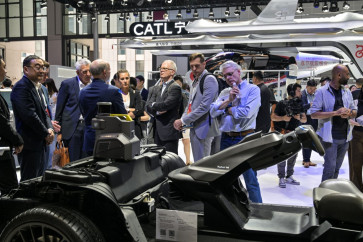Popular Reads
Top Results
Can't find what you're looking for?
View all search resultsPopular Reads
Top Results
Can't find what you're looking for?
View all search resultsInsight: China presents a model of state-led development
During the 1970s and 1980s, the world was economically and technologically besotted with Japan
Change text size
Gift Premium Articles
to Anyone
D
uring the 1970s and 1980s, the world was economically and technologically besotted with Japan. But the rise of Japan was never cast in bombastic and self-assured imperialistic terms, like that of the US. There was no talk of Japan as an aspiring superpower coming out of the shadows of American supremacy. Among global strategists, it was as if it was enough for Japan to heal itself from the collective wounds inflicted by its belligerence during World War II and to be counted among the top-tier nations.
The prolonged slowdown that started to strike Japan in the early 1990s diverted all admiring eyes away from it. With the spotlight then on South Korea, Taiwan, Singapore and Hong Kong, the ensuing attention was gradually switched to China.
Unlike the guarded rise of Japan, the ascent of China has brought much rumbling. Of crucial importance is not only the imperial posturing that China has been projecting on both regional and global stages, but perhaps more striking is the way the US has wriggled with angst as a global hegemon.
As expected, the US rallies its allies to keep China in check. In 2005, when a state-controlled Chinese oil firm, CNOOC, was forced out of bidding for California’s Unocal by the US Congress, the scaremongering about China was projected on a global stage.
It is within this geopolitics of global rivalry that any events or news of China are closely watched, and any moves by China are easily magnified to epic proportions in the public consciousness. Already in 2007, China’s aggregate export overtook that of the US. China outstripped the US in steel consumption in 1999 and again it overtook the US in fixed investment in 2009. It is simply a matter of time before China overtakes the US in imports, gross domestic products and power-purchasing parity and consumer spending. Whether China’s current defense budget will eventually overtake the US in 2025 is also a matter of probability.
Of course, all this statistical forecasting is still to be accounted for by what holds the story together. And the real story of hegemonic displacement takes much more than aggregate statistics. One of the most contested issues concerns the widely perceived umbilical link between China’s direction of economic reforms and its political structure. In a nutshell, the issue revolves around the question of whether China’s ongoing capitalist economy journey inevitably leads to a gradual unknotting of its political structure of command-style socialism.
The presumed inseparability between the two was widely believed on the eve of China’s ascension to the World Trade Organization in 2001. No less than Bill Clinton, then president of the US, believed that China’s ascension to the WTO would have a profound impact on its human rights policy and political liberty. The point was less about the fact than about the widespread sanguine confidence in the interlocking of a liberal economy with democratic politics. In an alternative, bizarrely inflated view, China’s ascension to the WTO was even taken to guarantee the future of democracy in China.
This is what makes any sign of popular restiveness in China, whether be labor strife or peasant unrest, readily couched in terms of the presumed unraveling of illiberal politics by a liberal economy. This rosy modernization thesis has of course been with us for many decades. It has been repeatedly employed to explain various social changes as well as to devise many reforms across the globe.
This argument in turn invokes a well-known older political-economic creed called le doux commerce, advocated by Montesquieu in his celebrated The Spirit of the Laws (1748). The core of the creed is an argument that broadening commercial activities would polish manners and civilize political autocracy into a more open system.
It is interesting that the creed can readily be found in its modern avatar of market-driven reforms expounded by the so-called Washington Consensus: “If it indeed proves difficult to identify cases of the sort of extensive policy reform needed to make the transition to an open, competitive, market economy that were not a response to a fundamental crisis, then one will have to speculate whether it could conceivably make sense to think of deliberately provoking a crisis so as to remove the political logjam to reform.”
To expect China to follow this scheme is surely laughable. Not because history is disinclined to repeat itself, but because both its current and future leaders will ensure that their country’s trajectory does not fall prey to any global hegemon’s straitjacket scheme. Its long, civilizational lineages are too intricate to be squeezed into a Washington Consensus-style blueprint of reform.
In all likelihood, what China presents to the world is a development model driven by the state, the crucial importance of industrial policy, and globally, more visible evidence that the world of capitalism is more varied than what we are made to believe. This, like any ambivalence under the sun, is good as much as bad news.
The writer is a lecturer in the Postgraduate Program at Driyarkara School of Philosophy, Jakarta.










